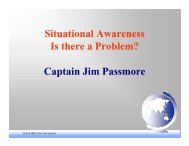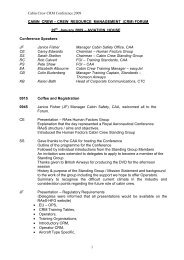Culture, Error, and Crew Resource Management - Human Factors ...
Culture, Error, and Crew Resource Management - Human Factors ...
Culture, Error, and Crew Resource Management - Human Factors ...
You also want an ePaper? Increase the reach of your titles
YUMPU automatically turns print PDFs into web optimized ePapers that Google loves.
<strong>Culture</strong>, <strong>Error</strong>, <strong>and</strong> CRM 9<br />
Ultimately, though, it is the responsibility of organizations to promote a safety culture <strong>and</strong> to maximize the positive<br />
<strong>and</strong> minimize the negative aspects of professional <strong>and</strong> national cultures.<br />
Threat <strong>and</strong> <strong>Error</strong> in Flight Operations<br />
<strong>Error</strong>s have been extensively studied in the laboratory, in training programs, <strong>and</strong> in post-mortem analyses of<br />
crew behavior in accidents <strong>and</strong> incidents. Similarly, systematic evaluations of the nature of external threats to safety<br />
are most frequently conducted when they are associated with adverse events. There is a dearth of systematic<br />
empirical data on the kinds, frequency, management, <strong>and</strong> resolution of threats <strong>and</strong> errors in normal flight operations.<br />
If safety efforts are to be optimally effective, such information is essential. In an effort to fill this gap, our research<br />
group has started a new program to examine threat <strong>and</strong> error in line audits of normal operations (described in a<br />
following section, Line Audits). An addendum to the Line/LOS Checklist, our form for the collection of systematic<br />
data during line flights (LLEC: Helmreich, Klinect, Wilhelm, & Jones, 1999) was developed to record threats <strong>and</strong><br />
crew-based errors, <strong>and</strong> crew behaviors during normal flights.<br />
Between July, 1997 <strong>and</strong> November, 1998, formal studies to investigate CRM, threat, <strong>and</strong> error management<br />
were conducted at three airlines using the LLEC 5 . The first was a commuter airline, where we observed 123 flight<br />
segments. The second <strong>and</strong> third were major airlines, with a focus on international, long haul operations. In these<br />
audits, we observed approximately 100 segments in each airline. For a detailed look at results of these audits, see<br />
Klinect, Wilhelm & Helmreich (in press). Of the flights observed, 72% experienced one or external threats (such as<br />
adverse weather, high terrain, mechanical malfunctions, language problems with ATC, etc.), with an average of 1.91<br />
per flight <strong>and</strong> a range of from 0 to 11. While many of the situations experienced were not serious in themselves, they<br />
did increase the level of risk <strong>and</strong> the probability of error. When a large number of external threats are associated with<br />
a particular flight, dem<strong>and</strong>s on the crew are greatly increased. We have found in earlier audits that conditions of high<br />
complexity with off-normal conditions may either stimulate crews to superior performance or lead to performance<br />
breakdowns (Hines, 1998).<br />
Let us now consider the right side of the threat <strong>and</strong> error model presented in Figure 1—the side that deals<br />
with crew-based error <strong>and</strong> error management. We operationally define this type of error as crew action or inaction<br />
that leads to deviation from crew or organizational intentions or expectations. Violations of formal requirements<br />
such as regulations, SOPs, <strong>and</strong> policies are included in this definition. We are indebted both to James Reason (1990,<br />
1997) <strong>and</strong> Patrick Hudson (1998) whose work has greatly influenced our efforts. While we recognize the distinction<br />
made by Reason <strong>and</strong> Hudson between errors <strong>and</strong> violations, we have labeled violations intentional noncompliance<br />
errors because we realize that the intent in violations is usually to shortcut what is seen as an unnecessary procedure<br />
or regulation or to use a more effective strategy. In developing a model of crew-based error, we found that the usual<br />
taxonomies <strong>and</strong> classifications of flightcrew error management did not fit our data well. This led us to develop a<br />
revised taxonomy of cockpit crew error that we feel may be of value for both research <strong>and</strong> operational evaluation.<br />
This model is shown in Figure 7.<br />
5 Excluded are cognitive errors that do not result in observable behaviors or verbalizations. It should also be noted<br />
that those observed are experts (as opposed to novices used in laboratory research or those in training) <strong>and</strong> that the<br />
crews’ behaviors are highly consequential. Observers, especially on long flights, were not present at all times on the<br />
flightdeck (normally taking a rest period during cruise at altitude). As a result, the recorded incidence of error is a<br />
conservative estimate of the actual frequency.




